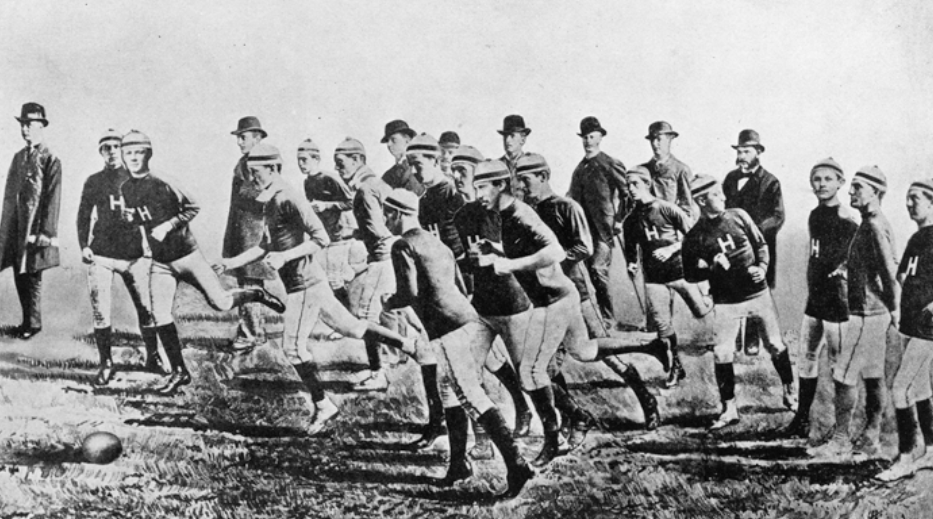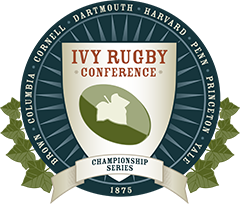"The Cycle of Harvard Football: 'Bloody Monday,' Haughton Era, Rose Bowl--and De-Emphasis"

Long ago, in a simpler, kindlier age, Harvard University was a football power. In 1919, for example, its football machine rolled up a total of 222 points, as against 13 for its opponents. Its record marred only by a 10-10 tie with Princeton, the Crimson accepted a bid to Pasadena; and on January 1, 1920, Harvard ushered in a new decade by becoming the first Eastern team to win the Rose Bowl.
Things were never to be quite that good again. Harvard football had come a long way from "Bloody Monday; and although Yale was to be The Game in college football for many years to come, Saturdays were going to get an awful lot quieter.
By 1950, Harvard was become a synonym for the nadir of collegiate football; and the Class of 1925, which remembered better days, was to give $35,000 to the College for the frank purpose of athletic scholarships. With this gesture amateur football, which had known Harvard as a cradle, now looked down into its open grave.
Ironic that Harvard, the originator of big-time football, was soon to repudiate it utterly. Big-time football was no longer a game for amateurs; and Harvard, unwilling to become an athletic powerhouse, became a moral one.
The presidents of the Big Three--the phrase had been coined beccause of football domination--in 1951 issued a statement known as the "Ivy Group Agreement." In this, it was agreed to abolish football clinics, spring practice, and post-season games; to set up a round-robin with schools in the Ivy League; and to reduce the length of the season.
This supposedly put an end to the controversy about the place of football at Harvard, which had raged since the middle of the 19th century.
Originally, the game here was a form of hazing, and was played as a contest between sophomores and the incoming freshmen. The ball was relatively unimportant on these occasions, which soon became known as "Bloody Mondays," and were cast into limbo.
It was in 1871 that football, after being prohibited by a faculty decree for 11 years, was resurrected by a group of students who had played the game in prep school. The Cambridge Common was selected as the field until the City Council, prompted by indignant towns-people, kicked them off.
This early game was known as the "Boston game," a sort of cross between rugby and a free-for-all. A curious feature was that a player could run and throw or pass the ball only if he were being pursued by an opponent. When the opposing player gave up pursuit he called out to the runner, who had to stop and kick the ball.
In 1874, some students met representatives of McGill University--in what is generally recognized as the legitimate predecessor of modern football. Since McGill played under rugby rules, the teams agreed to meet twice, first playing the "Boston game" and then the McGill rugby. Harvard won the first match easily, and held the Canadians to a scoreless tie at their own game. A half-dollar admission was charged, and the $250 collected was used by both teams for a drunken orgy.
The next challenge went to Yale. Three half-hour periods were played, no time outs, fifteen players on a side, no padding worn. Harvard won, four goals and four touchdowns to nothing. Forty students went down to New Haven for the game.
The following year, only 11 men were on a side, and two 45-minute periods were played. Early in the second half Yale kicked a field goal for what proved to be the margin of victory, and spectators swarmed on the field and wasted 20 minutes of playing time carrying the Yalies around on their shoulders.
The Eighties saw radical changes in Harvard football: systematic coaching, organized practice, a training table, and faculty rulings. Games at first were not allowed in Cambridge until after four o'clock in the afternoon, and in 1885 the sport was placed under a University ban--lifted the following winter. In the fall of 1890, a Harvard team broke through and defeated Yale for the first time since 1875.
Training was also being improved. 1889 saw the first spring practice. Two years later a crude and brutal machine called the tackling dummy came to Harvard. Dr. W. M. Conant '79 was made team doctor and began a custom of players' retiring from the field between halves for rubdowns and first aid.
After football had ridden out the storm of protest against its brutality, Harvard coaches began to devise even more brutal plays. Yale was no laggard either; and the second half of The Game of 1892 saw the introduction of collegiate football to the "Flying Wedge." "Guards Back," "Tackles Back," the "Turtle Back," and other brawny plays soon followed. By 1894 the games were so gory that a two-year break in relations with Yale resulted.
1897 was a banner year for two reasons: first, relations with Yale were resumed; second, W. Cameron Forbes '92 was appointed head coach. This marked the beginning of scientific coaching at Harvard. The team of 1889, guided in its football theories by Forbes, had in the lineup four men who were to direct Harvard coaching for 14 of the next 17 years. They were B. H. Dibblee '99, W. T. Reid '01, J. W. Farley '99, and Percy Haughton. Haughton, perhaps the greatest football coach, was appointed in 1908. Unfortunately for him, the athletic committee had abolished professional coaching, and he served without salary that first year.
The following season, Haughton had to revamp the offense completely, as the last remnants of the brute force plays were abolished, with rules prohibiting pushing and pulling of the runner. The wedge had disappeared long since; it had to. Public outcry over football deaths and injuries had reached such an extent that in 1906 President Roosevelt influenced the College to stop the game once again. Haughton's arrival signaled resumption.
The brightest era of Harvard football was beginning. The first football stadium had been built at Soldiers' Field in 1902--with funds donated by an alumnus--at a cost of $295,000. For three seasons, 1913-15, Harvard was recognized unquestionably as the best team in the country. Its stadium had a 55,000 seating capacity; and it was only long after Haughton had left that interest was to wane and 20,000 of these seats were to be removed.
The 1914 game was the first played in Yale Bowl, and the first in which a new weapon--the lateral pass--was used against the Crimson. But Haughton was prepared. The defense spread out over the field, leaving only three men in the line.
The next year an individual hero overshadowed the coaching. Richard King '17 gained immortality by scoring the first touchdown against Yale in Soldiers Field Stadium, which had been in use since 1903. On that day the Crimson earned its most satisfying triumph, pushing across five more touchdowns to defeat the Elis, 41-0.
In the pre-World War I days, interest in football gradually spread across the nation, and embryonic squads of the future lords of the sport--Army, Notre Dame, Michigan, began to appear.
Near the end of the War the traditional "Ivy" founders of the sport began to show an uneasiness about the hold football had over Americans. In an attempt to curb certain practices adopted by colleges anxious to become football powers, the heads of Harvard, Yale and Princeton met and set forth the "Presidents' Agreement," which outlined specific rules to be followed in recruiting and giving aid to players.
President Lowell, in his Report to the University, stated: "All alumni are urged to refrain from offering an inducement to any schoolboy to enter Harvard, when the compelling motive is his athletic skill." The remark was taken with a grain of salt by loyal sons. After all, Harvard was the Rose Bowl champion, wasn't she?
But New Year's Day, 1920, was to be the high-water mark. The tide began to ebb.
At first it was hardly noticeable. In 1921 the College introduced an innovation, by playing a "doubleheader" football game. Its first team met B.U., the second team played Middlebury, and both squads shut out their opponents. Moreover, games did not seem to be lacking stamina. In 1926, the roughness of the Princeton game caused that University to sever athletic relations with Harvard for two years.
The important change in athletics which occurred in the Twenties, however, concerned not only football, but rather constituted a break with the University's long-standing official aloofness towards athletics.
The policy of "athletics for all" had been announced in 1919, when compulsory PT was instituted for freshmen. Seven years later the University granted real recognition to inter-collegiate athletics, and assumed a measure of direct control over the heretofore autonomous program. In 1926, William J. Bingham '16 was made the first Director of Athletics.
